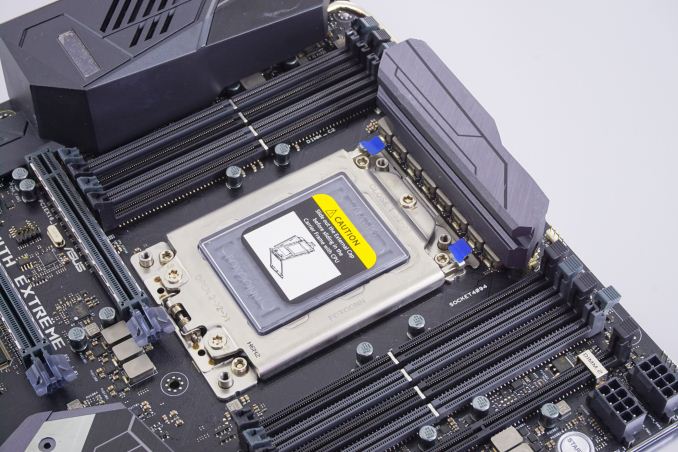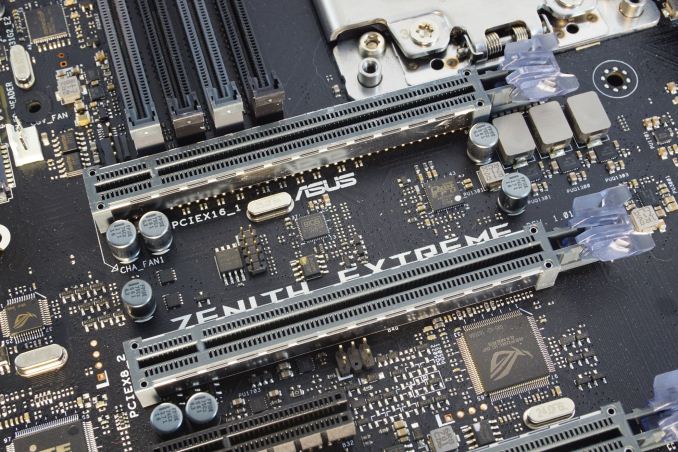The ASUS X399 ROG Zenith Extreme Motherboard Review: Top Tier Threadripper
by E. Fylladitakis on July 17, 2018 10:30 AM EST- Posted in
- Motherboards
- Gaming
- Asus
- ROG
- Overclocking
- ThreadRipper
- X399
ASUS X399 ROG Zenith Extreme Conclusion
The ASUS X399 ROG Zenith Extreme is a product that the company developed to be the pinnacle of Ryzen Threadripper motherboards. It is a motherboard designed and marketed primarily for gaming and overclocking, yet it also has a very long list of features. As a matter of fact, the ASUS X399 ROG Zenith Extreme is so loaded that ASUS's engineers could barely fit everything on the E-ATX PCB.
Despite the use of the E-ATX PCB, the ASUS X399 ROG Zenith Extreme is not actually as overloaded as one would initially expect it to be. The sheer number of subsystems, ports, and connectors that the ASUS X399 ROG Zenith Extreme has does not really stand out when compared to top-tier designs from other manufacturers. If anything, the designer had to sacrifice two SATA ports just to make space for the U.2 PCIe ×4 port, making the ASUS X399 ROG Zenith Extreme the motherboard with the fewest SATA ports available at the time of this review, where even mATX designs come with eight SATA ports. The lack of space becomes apparent when realizing that the designer was forced to move two of the M.2 slots onto a daughterboard and the 10G NIC to a PCIe ×4 card. Much of the space on the motherboard is occupied by overclocking-related chips and features, such as the several ROG chipsets and the TPU KB3720Q chipset that performs some of the automated overclocking functions. The ASUS X399 ROG Zenith Extreme also has hardware support for LN2 cooling, which may be useful only to competition overclockers but hints just how much weight ASUS placed on overclocking support with this motherboard.
The main difference between the ASUS X399 ROG Zenith Extreme and the competition is not the number of features but their implementation. Yes, nearly all of the AMD X399 motherboards come with a Wi-Fi/Bluetooth card onboard but the ASUS X399 ROG Zenith Extreme is the only one that comes with a 2x2 MU-MIMO 802.11a/b/g/n/ac card that also supports 802.11ad 4.6 Gbit WiGig. Certainly, all of the AMD X399 motherboards have their sound circuitry based on Realtek's ALC 1220 chipset but the ASUS X399 ROG Zenith Extreme has its audio circuitry isolated via PCB division isolation (and not just the left/right channels). Sure, most motherboards that come with a 10G NIC are using the AQUANTIA AQC107, the same NIC that the ASUS X399 ROG Zenith Extreme does, but ASUS supplies it in the form of a very well cooled PCIe ×4 card that also allows the end user to choose whether to install it or not, or to use another PCIe ×4 card in its place.
One of the greatest advantages that the ASUS X399 ROG Zenith Extreme has is it very powerful circuitry. ASUS did not go overboard with the number of phases or even with the main circuitry design, utilizing an 8+3 phase approach with a digital per-phase controller similar to what other manufacturers are using on their advanced AMD X399 motherboard offerings. The difference is that ASUS went with components that are greatly oversized for the power requirements of a stock Ryzen Threadripper processor, allowing for greater overclocks to the achieved. A powerful circuitry is essential for advanced overclocking with Ryzen Threadripper processors because, as we saw in the previous pages of this and other AMD X399 reviews, the energy requirements of Ryzen Threadripper processors increase abruptly when overclocking them.
Although the ASUS X399 ROG Zenith Extreme is a fantastic product, it definitely is not faultless. The need to place a sixth expansion card slot forced the designer to place the top PCIe slot too close to the CPU's socket. This layout mishap greatly reduces the compatibility of the motherboard with tower air coolers, as nearly all (if not all) of the coolers will block the installation of a graphics card in the top slot (although users can move it to the third full-size slot). We also are not confident regarding the placement of the onboard M.2 slot, as having the chipset heatsink cooling it does not seem like a very good idea, especially when overclocking. The chipset's heatsink is not large enough to cope with the heat of an overclocked chipset and a stressed SSD at the same time. Finally, there is the "meh" feature of the OLED on the I/O shield, where its size and placement hardly makes it an interesting feature at all.
Despite the aforementioned design blunders, the ASUS X399 ROG Zenith Extreme definitely is the best AMD X399 motherboard currently available for overclocking and it comes with the most advanced features currently available. However, the retail price of the ASUS X399 ROG Zenith Extreme is frightening, with the motherboard currently retailing above $500. It is a product for users that do not really care about the cost and want the very best there is or, in rare cases, for those who absolutely need one of its unique features and/or are interested in competitive overclocking.
AnandTech's AMD Ryzen Threadripper and X399 Motherboard Coverage
- The AMD Ryzen Threadripper 1950X and 1920X Review: CPUs on Steroids
- An AMD Threadripper X399 Motherboard Overview
- Analyzing Threadripper Thermals: Big Base Cooling Wins
- The GIGABYTE X399 DESIGNARE EX Motherboard Review
- The ASRock Fatal1ty X399 Professional Gaming
- AMD Reveals Threadripper 2 : Up to 32 Cores, 250W, X399 Refresh
- GIGABYTE’s X399 Aorus Extreme: The Threadripper 2 Halo Motherboard
- MSI's New Threadripper 2 Motherboard on Steroids: X399 Creation
- New EKWB Threadripper X399 Monoblocks for GIGABYTE and MSI












25 Comments
View All Comments
jordanclock - Tuesday, July 17, 2018 - link
It's nice to have drivers available in situations where you either don't have immediate internet access or where you cannot access the internet because your OS install doesn't include necessary drivers, like for graphics or network adapters.twtech - Tuesday, July 17, 2018 - link
This is far from the worst example, but not having built a system in a few years - it seems like I've come back to find every motherboard now looks like some blinged-out kids toy from the dollar store. Lights, weirdly-shaped plastic shrouds with big gamer logos that have no functional purpose, etc.Yuriman - Wednesday, July 18, 2018 - link
The retail PC segment is in decline. Manufacturers are doing everything they can to attract a new generation of buyers.Awful - Tuesday, July 17, 2018 - link
I have no use case that requires 32 cores, 10Gb networking, or even wifi in a desktop so I wouldn't buy one of these. But I still waaannnt one!Alien959 - Wednesday, July 18, 2018 - link
I want to comment about m.2 cooling. According to numerous respected internet outfits and even the JEDEC specification and testing, nand flash lasts longer at higher temperatures and is recommended to be above 40c. The only part that needs cooling is the controller, but almost all cooling plates cool the nand.kazoOC - Thursday, July 19, 2018 - link
Notice one thing: most boards share the m2 heatsink with the PCH, which is responsible for pci and sata. It will always get relatively warm while still keeping the m2 drives away from throttling.Now, aftermarket m2 heatsink are another story but still a valid choice in poorly ventilated cases. Just take care to avoid contact with nand chips by peeling off portions of the thermal pad.
virpuain@gmail.com - Wednesday, July 18, 2018 - link
A quick glare suggests this VRM will be dissipating 30W at 1.4V@176A. That being said the 32 cores TR better come with a maximum TDP of 250W.For the pricetag this board is lacking alot in the VRM side of things, especially if you consider this a very premium board ( with AAA+++ premium pricetag ) with a VRM that is actually worse than what you have on a few AM4 boards like the X370 Taichi and C7H.
This VRM is pretty much like what you have with the X370 GT7, a $ 120 board for AM4.
Oxford Guy - Thursday, July 19, 2018 - link
ASUS and Gigabyte both sold hybrid air/water VRM cooling, beginning in 2013 with ASUS — for quad core CPUs. But, no — we don't need water cooling for VRMS on a board like this. Instead, we need tiny fans and LEDs.a351must2 - Wednesday, July 18, 2018 - link
I just have to comment on this ... I have this motherboard and would say the heatsink for the included 10GB card is necessary. I've actually been having problems with the 10GB network dropping offline randomly and traced it down to the card overheating. The heatsink is big, but it also needs some airflow near it (my case provides none). I now have an additional slot fan mounted that moves air across the 10GB card and my other addon cards (older intel dual GB nic and a 9211 sas controller).Also, if this review had been done 9 months ago when I built mine, there would've been some mention of the buggy bios and memory support. I made the mistake of buying unsupported DDR3200 ram (Corsair kit for Intel) and after reading a bit was feeling lucky I got it to run at 3000. A bios update in January got it to run at 3200 though and I believe most of the fan speed control issues have been resolved.
As for power, when messing with overclocking mine I've had the 1950X draw over 350 watts by itself using this board. That'll easily cover a 250Watt TDP 32 core processor ... I'm sure we'll see the limits when the new processors become available though.
Timur Born - Friday, July 20, 2018 - link
Thanks for the article.I find the DPC Latency section misleading. There is no mention what power profile and BIOS (C-states) settings were used and if the values reported are maximum or average values. Look at this example:
Highest measured interrupt to DPC latency (µs): 354,514229
Average measured interrupt to DPC latency (µs): 2,480283
Quite the difference. And 354 µs maximum still is not a problem even at lowest audio buffer settings.